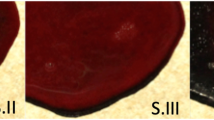Abstract
In forensic case work, blood stain pattern analysis frequently aids in deducing the chain of actions or parts thereof taking place during an event leading to blood loss. Wiped single blood stains and/or groups of blood stains are seen at a majority of complex crime scenes. The appearance of wiped blood stains depends on droplet volume and stain age (as a function of blood viscosity and the degree of stain skeletonization) and characteristics of the stained surface (i.e., texture, temperature). Furthermore, based on the biochemical and biophysical properties of blood, not only the drying processes, but also complex coagulation cascades are relevant to the assessment of wiped blood stains. This study was designed to determine if anticoagulation therapies markedly affect the wipeability of blood stains over times elapsed since deposition and the overall drying process. A total of 813 blood stains, originating from donors being treated with acetylsalicylic acid (ASA), clopidogrel + ASA, low-molecular-weight heparin, or rivaroxaban, were dropped on common household tiles. Wipeability at an ambient temperature of 20 °C was tested for 22 time periods (1, 2, 3, 5, 10, 15…105 min since deposition). Whereas stains consisting of untreated blood were dried within 55 min, wipeability of all droplets originating from donors with prior anticoagulation treatment showed pronounced delays compared with the control, ranging from 20 min (ASA and clopidogrel + ASA) to 45 min (rivaroxaban). This pronounced effect was not seen in earlier studies, which might be explained by the higher volume of droplets used in this study, which resulted in a shift in relevance from drying to clotting processes. Significant differences between the drying times of the various anticoagulation regimes might be attributed to anticoagulant activity against different targets in the coagulation cascades. In conclusion, anticoagulation treatment prior to blood loss significantly affected the wipeability of blood stains. Anticoagulation therapy should therefore be taken into account in the analysis of blood stain patterns.





Similar content being viewed by others
References
Bevel T, Gardener RM (1997) Bloodstain pattern analysis with an introduction to crime scene reconstruction. CRC, Boca Raton
Gardener RM (2002) Directionality in swipe patterns. J Forensic Ident 52(5):579
Kettner M, Schmidt A, Windgassen M, Schmidt P, Wagner C, Ramsthaler F (2015) Impact height and wall distance in bloodstain pattern analysis—what patterns of round bloodstains can tell us. Int J Legal Med 129(1):133–140
Peschel O, Kunz SN, Rothschild MA, Mützel E (2011) Blood stain pattern analysis. Forensic Sci Med Pathol 7(3):257–270
Stuart HJ, Kish PE, Sutton TP (2005) Principles of bloodstain pattern analysis. Theory and practice. Taylor & Francis, Boca Raton
Anderson S, Howard B, Hobbs GR, Bishop CP (2005) A method for determining the age of a bloodstain. Forensic Sci Int 148:37–45
Pizzola PA, Roth S, De Forest PR (1986) Blood droplet dynamics—I. JFSCA 31(1):36–49
Pizzola PA, Roth S, De Forest PR (1986) Blood droplet dynamics—II. JFSCA 31(1):50–64
Ramsthaler F, Schmidt P, Bux R, Potente S, Kaiser C, Kettner M (2012) Drying properties of bloodstains on common indoor surfaces. Int J Legal Med 126(5):739–746
Ramsthaler F, Schlote J, Wagner C, Fiscina J, Kettner M (2016) The ring phenomenon of diluted blood droplets. Int J Legal Med 30(3):731–736
Raymond MA, Smith ER, Liesegang J (1996) The physical properties of blood—forensic considerations. Sci Justice 36:153–160
White RB (1986) Bloodstain pattern of fabrics—the effect of drop volume, dropping height and impact angle. J Canadian Society Forensic Sci 19(1):3–36
Altman DG (1993) Construction of age-related reference centiles using absolute residuals. Stat Med 12:917–924
Altman DG, Chitty LS (1993) Design and analysis of studies to derive charts of fetal size. Ultrasound Obstet Gynecol 3:378–384
Altman DG, Chitty LS (1994) Charts of fetal size: 1. Methodology Br J Obstet Gynecol 101:29–34
Jones R, Payne B (1997) Clinical investigation and statistics in laboratory medicine. ACB Venture Publications, London
Wright EM, Royston P (1997) Simplified estimation of age-specific reference intervals for skewed data. Stat Med 16:2785–2803
Zhao L, Fletcher S, Weaver C, Leonardi-Bee J, May J, Fox S (2005) Effects of aspirin, clopidogrel and dipyridamole administered singly and in combination on platelet and leucocyte function in normal volunteers and patients with prior ischaemic stroke. Thromb Haemost 93(3):527–534
Bernstein RA, Albers GW (2005) Oral antiplatelet therapy. JAMA 293:793–794
Geoghegan PH, Spence CJ (2016) Experimental and computational investigation of the trajectories of blood drops ejected from nose. Int J Legal Med 30(2):563–568
Kunz SN, Adamec J, Grove C (2016) Analyzing the dynamics and morphology of cast-off pattern at different speed levels using high-speed digital video imaging. J Forensic Sci. doi:10.1111/1556-4029.13299
Stotesbury T, Illes M, Jermy M, Taylor M, Wilhelm J, Vreugdenhil A (2016) Three physical factors that affect the crown growth of the impact mechanism and its implications for bloodstain pattern analysis. Forensic Sci Int 266:254–262
Kim S, Ma Y, Agrawal P, Attinger D (2016) How important is it to consider target properties and hematocrit in bloodstain pattern analysis? Forensic Sci Int 266:178–184
de Castro T, Nickson T, Carr D, Knock C (2016) Interpreting the formation of bloodstains on selected apparel fabrics. Int J Legal Med 127(1):251–258
Author information
Authors and Affiliations
Corresponding author
Ethics declarations
Conflict of interest
The authors declare that they have no conflict of interest.
Rights and permissions
About this article
Cite this article
Ramsthaler, F., Kröll, AK., Verhoff, M. et al. Effect of anticoagulation therapy on drying times in bloodstain pattern analysis. Int J Legal Med 131, 955–961 (2017). https://doi.org/10.1007/s00414-017-1599-1
Received:
Accepted:
Published:
Issue Date:
DOI: https://doi.org/10.1007/s00414-017-1599-1




